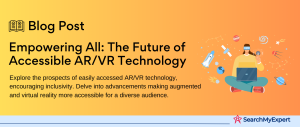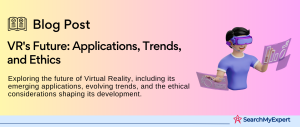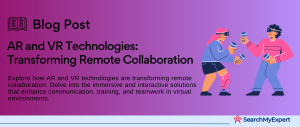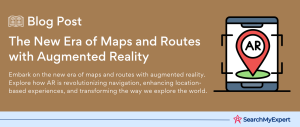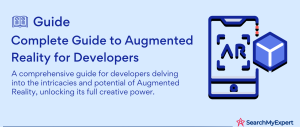Defining Augmented Reality (AR) and Virtual Reality (VR)
Augmented Reality (AR) and Virtual Reality (VR) are two of the most exciting and rapidly evolving technologies in the modern digital era. Although they are often mentioned together, they have distinct characteristics and offer unique experiences.
- Augmented Reality (AR):
AR enhances the real world by overlaying digital information onto it. Imagine looking through your smartphone camera and seeing digital images superimposed onto the real world – that’s AR in action. It doesn’t replace your reality, it simply adds to it. This technology is becoming increasingly popular in various fields, from gaming (like the famous Pokémon GO) to practical applications in interior design, where users can visualize furniture in their homes before purchasing. - Virtual Reality (VR): In contrast, VR creates a completely immersive experience that shuts out the physical world. Using VR headsets, such as Oculus Rift or HTC Vive, users are transported into a fully digital environment, where they can interact with 3D worlds. It’s like stepping into a completely different universe where everything you see and hear is simulated.
Exploring the History and Evolution of AR & VR
The journey of AR and VR from mere scientific concepts to mainstream technologies is a fascinating one.
- Augmented Reality: The concept of AR has been around since the 1960s, with Morton Heilig’s invention of the Sensorama – an early example of immersive, multi-sensory technology. However, it wasn’t until the 1990s that AR started to gain traction, with the development of the first commercial AR systems used in television and military training. The 2010s saw a significant breakthrough with the advent of mobile AR apps, bringing this technology into the hands of everyday consumers.
- Virtual Reality:
VR’s roots can be traced back to the 1950s with the creation of the first flight simulators. The 1980s and 1990s witnessed major strides in VR technology, though it remained largely inaccessible to the public due to high costs and limited technology. The 21st century has seen a VR renaissance, thanks to advancements in computing power, graphics, and sensor technologies, making VR headsets both affordable and practical for consumers.
Understanding the Applications of AR & VR
Both AR and VR have found applications across a wide range of industries, transforming how we work, learn, and entertain ourselves.
- Gaming and Entertainment:
This is the most visible and popular application of AR and VR. VR games offer an immersive experience that traditional gaming cannot match. AR, on the other hand, has brought a new dimension to gaming by blending digital elements with the real world, as seen in games like Pokémon GO. - Education and Training:
AR and VR are revolutionizing education and training. They provide interactive, immersive learning experiences that were previously impossible. For example, medical students can practice surgeries in a virtual environment, reducing risk and improving learning outcomes. - Healthcare: In healthcare, AR and VR are used for everything from surgical simulations to patient care. AR can assist surgeons by overlaying critical information during procedures, while VR has been used for pain management and therapy for conditions like PTSD.
- Retail and Interior Design: In retail, AR allows customers to visualize products in their homes before buying, significantly enhancing the shopping experience. Similarly, interior design has been revolutionized by AR, enabling users to experiment with different furniture and decor in their actual living spaces virtually.
- Tourism and Exploration:
VR offers virtual travel experiences, allowing people to explore distant or inaccessible places from the comfort of their homes. AR, meanwhile, can enhance real-world travel by providing travelers with interactive information about their surroundings.
Hardware Essentials
When it comes to creating and experiencing AR and VR, hardware plays a crucial role. The evolution of this hardware has been instrumental in bringing these technologies to the mainstream.
- VR Headsets:
The most recognizable piece of VR hardware is the headset. These headsets, such as the Oculus Rift, HTC Vive, and PlayStation VR, provide immersive visual and audio experiences. They range from high-end models offering room-scale tracking and high-resolution displays to more accessible options like the Oculus Quest that offer a balance of performance and portability. - AR Smart Glasses: For AR, smart glasses are at the forefront. Devices like Microsoft’s HoloLens and the Magic Leap One allow users to see digital images overlaid onto the real world. These glasses are equipped with cameras, sensors, and sometimes even spatial computing capabilities to blend digital content seamlessly with the real world.
- Other Essential Equipment: Besides headsets and glasses, other equipment like motion tracking sensors, haptic feedback devices, and specialized controllers enhance the AR/VR experience. These tools help users interact more naturally with the virtual world, increasing the sense of immersion.
Software Platforms and Game Engines
Creating AR and VR experiences requires powerful software platforms and game engines.
- Unity and Unreal Engine:
Unity and Unreal Engine are the two most popular game engines used in AR and VR development. Both offer robust tools for creating immersive 3D environments and are favored for their flexibility, high-quality graphics, and large supportive communities. Unity is particularly popular for mobile VR and AR applications, while Unreal Engine is known for its high-fidelity graphics capabilities. - ARKit and ARCore: For AR development, Apple’s ARKit and Google’s ARCore are leading platforms. They allow developers to create AR experiences for iOS and Android devices, respectively. These platforms provide tools for environmental understanding, motion tracking, and light estimation, making it easier to blend digital objects with the real world.
- Programming Languages and Frameworks:
Exploring Relevant Languages and Specific AR & VR Development Frameworks
The choice of programming languages and frameworks is critical in AR and VR development
- C# and C++:
C# is widely used in Unity for both AR and VR development due to its simplicity and powerful features. Unreal Engine primarily uses C++, known for its performance and control. Both languages are well-suited for the computational demands of AR and VR. - JavaScript and Web-Based Frameworks:
JavaScript, along with web-based frameworks like A-Frame and Three.js, is increasingly used for building browser-based AR and VR experiences. These tools are making AR/VR more accessible as they can run on standard web browsers without the need for additional software. - Specific AR & VR Development Frameworks: There are frameworks specifically designed for AR and VR development. For instance, Vuforia for AR enables the recognition of images and objects, and SteamVR for VR provides support for headset and controller tracking.
Modeling 3D Assets
3D modeling is the cornerstone of creating immersive AR and VR experiences. It involves the creation of three-dimensional objects and environments that can be used in virtual worlds.
- Fundamentals of 3D Modeling: The process begins with the creation of a basic shape, known as a mesh, which is made up of vertices, edges, and faces. This mesh can be manipulated to form complex structures, from simple objects like a ball to intricate models like a car or a human figure.
- Tools for 3D Modeling:
There are numerous 3D modeling software options available, such as Autodesk Maya, Blender, and 3ds Max. These tools offer a range of functionalities for building detailed models, including sculpting, texturing, and rigging (adding a skeleton for animation). - Creating Environments:
Beyond individual objects, 3D modeling is also used to create entire environments. This is particularly important in VR, where the user is fully immersed in a digital world. The creation of these environments requires careful consideration of scale, perspective, and spatial relations to ensure a realistic and engaging experience.
Texturing and Lighting
Texturing and lighting are critical in making 3D models look realistic and convincing in AR and VR.
- Texturing:
This process involves adding colors, patterns, and details to the surface of 3D models. Textures give objects a more realistic appearance, simulating materials like metal, wood, or fabric. Advanced techniques like bump mapping and normal mapping are used to create the illusion of depth and detail on the surface of an object. - Lighting:
Proper lighting is essential in 3D environments. It not only illuminates the scene but also adds mood, depth, and realism. In VR and AR, lighting needs to be strategically placed to mimic how light behaves in the real world. This involves understanding and implementing different lighting techniques such as ambient, point, directional, and spotlighting.
Animation and Interaction
Animation and interactivity are what make AR and VR experiences truly immersive and engaging.
- Animation Techniques: Animation in 3D involves bringing models to life by creating movement. This could range from simple animations, like a door opening, to complex ones, like a character walking or talking. Keyframe animation and motion capture are commonly used techniques in this space.
- Interactive Elements:
For AR and VR, interaction is key. This involves programming objects and environments to respond to user inputs, whether it’s through a controller, gesture, or voice command. Interactivity increases engagement and provides a more realistic experience. - Physics and Realism: Implementing physics in the virtual environment adds to its realism. This includes simulating gravity, collision, and other real-world physics behaviors. Physics engines integrated into game development platforms play a crucial role here.
Understanding Various Sensor Technologies
Sensor technology is a vital component in bridging the gap between the real and virtual worlds in AR and VR. These sensors track user movement and orientation, allowing for a seamless and interactive experience.
- Gyroscopes and Accelerometers:
These are the most common sensors found in VR and AR devices. Gyroscopes measure the rotation or orientation of the device, while accelerometers detect linear acceleration. Together, they provide the necessary data to determine the position and movement of the user’s head or device, translating it into the virtual environment.
Other Essential Sensors:
- Magnetometers:
Often used in conjunction with gyroscopes and accelerometers, magnetometers measure the magnetic field around the device. This helps in determining the device’s direction relative to the Earth’s magnetic field, enhancing orientation tracking. - Proximity Sensors:
These sensors detect the presence of nearby objects or surfaces, particularly useful in VR headsets to turn off the display when the headset is not in use, saving power and improving user comfort. - Optical Sensors:
Used in high-end VR systems, optical sensors track the user’s position in a room, enabling room-scale VR experiences. They work by tracking special markers or the lights on the VR headset and controllers.
Spatial Mapping and Object Recognition
Spatial mapping and object recognition technologies enable AR devices to understand and interact with the physical world.
- Spatial Mapping: This involves creating a 3D map of the user’s environment. AR devices, equipped with cameras and depth sensors, scan the surroundings to generate a digital replica. This allows digital objects to be placed and anchored in the real world, enhancing the realism of the AR experience.
- Object Recognition:
AR devices and applications use object recognition to identify and interact with real-world objects. This can be achieved through various technologies like computer vision, machine learning algorithms, and image processing. For example, AR apps can recognize specific products, landmarks, or even facial features to trigger certain AR effects.
Calibration and Optimization
Calibration and optimization are crucial for a smooth AR/VR experience.
- Calibration: This process involves setting up the device to accurately track movements and orientation. It includes calibrating sensors to the user’s specific environment and adjusting settings to account for variations in lighting, space size, and user preferences.
- Optimization for Performance:
To ensure smooth tracking, AR and VR systems must be optimized for performance. This involves balancing the computational load to prevent lag, which can disrupt the immersive experience and cause discomfort. Optimization techniques include adjusting the frame rate, resolution, and processing algorithms to achieve the best performance for the given hardware. - Sensor Fusion:
Combining data from multiple sensors (sensor fusion) enhances accuracy and reduces reliance on a single sensor, which can be prone to errors or limitations. For instance, using gyroscopes in conjunction with accelerometers allows for more accurate tracking of complex movements.
Interface Design and Interaction
Interface design in AR and VR is fundamentally different from traditional screen-based interfaces due to the immersive nature of these technologies. The design and interaction paradigms need to be intuitive, natural, and comfortable for users.
- Intuitive Navigation:
In AR and VR, navigation must be as natural as moving in the physical world. This involves implementing gesture controls, gaze-based navigation, and voice commands. For example, in VR, a user might reach out and grab objects with a hand controller, while in AR, a user might use hand gestures to interact with virtual objects overlaid in the real world. - User-Friendly Manipulation: Manipulating objects in AR and VR should feel responsive and realistic. This includes grabbing, rotating, or resizing virtual objects. Haptic feedback in controllers can enhance this experience by providing tactile responses to actions, making the interaction feel more real.
- Contextual Interfaces:
Interfaces should appear only when needed and be contextually relevant to the user’s current task or environment. Overloading the user with information or controls can be overwhelming and break immersion.
Storytelling and Narrative Design
Storytelling in AR and VR can be a powerful tool to create engaging and memorable experiences.
- Immersive Storytelling:
Unlike traditional storytelling, AR and VR allow users to be part of the story. Designers can create narratives where users can influence or change the outcome, leading to a more personal and engaging experience. - Environmental Narratives:
The environment itself can tell a story in AR and VR. Designers can use the virtual environment to guide users, reveal plot elements, or create mood and atmosphere that contribute to the narrative. - Interactive Elements:
Adding interactive elements to the narrative can enhance engagement. This could include solving puzzles in a VR game or interacting with virtual characters in an AR story.
Accessibility and Inclusivity
Accessibility and inclusivity are crucial in the design of AR and VR experiences to ensure they can be enjoyed by a wide range of users.
- Designing for Different Abilities: This includes providing options for different levels of mobility, vision, and hearing. For instance, offering voice commands for users who might not be able to use hand controllers, or providing subtitles and visual cues for users with hearing impairments.
- Adjustable Settings: Users should be able to adjust settings to suit their needs and comfort levels. This can include options to change text size, control sensitivity, and adjust brightness or contrast.
- Avoiding Motion Sickness:
Motion sickness can be a significant issue in VR. Designers should ensure smooth motion and provide options to minimize fast movements or implement teleportation as a form of movement to reduce discomfort. - Testing with Diverse Users: It’s important to test AR and VR experiences with a diverse group of users. This helps identify any issues with accessibility and usability that might not be apparent initially.
Debugging and Performance Optimization
In the development of AR and VR experiences, ensuring optimal performance and a bug-free user experience is paramount. This phase is crucial for refining your creation into a polished product.
Debugging: This involves systematically identifying and fixing bugs in the application. Common issues in AR and VR include glitches in graphics, tracking errors, or problems in user interaction. Using debugging tools provided by development platforms like Unity or Unreal Engine can help identify and resolve these issues.
Performance Optimization:
AR and VR applications demand high processing power to run smoothly. Optimization techniques include:
- Reducing Resolution or Detail in Models:
Simplifying models or using lower resolution textures can significantly improve performance without noticeably affecting visual quality. - Optimizing Code:
Efficient code can reduce processing load. This might involve streamlining algorithms or using more efficient data structures. - Balancing Graphics and Performance:
Adjust lighting effects, shadows, and particle effects to find the right balance between visual quality and smooth performance.
Playtesting and User Feedback
Playtesting is a critical step in the development process. It provides real-world insights into how users interact with your AR or VR application.
- User-Centered Testing:
Involve a diverse group of users to test the application in various scenarios. This helps in understanding how different users perceive and interact with your application. - Gathering Feedback: Collect feedback on various aspects such as user interface, ease of use, enjoyment, and any physical discomfort like motion sickness. Tools like surveys, interviews, and observation can be useful in gathering this information.
- Iterative Improvement: Use the feedback to make iterative improvements to your application. This might involve tweaking the interface, adjusting the difficulty of a VR game, or improving the accuracy of AR tracking.
Deployment and Distribution
Once your AR or VR application is polished and ready, the next step is deployment and distribution.
- Choosing the Right Platform:
Different platforms have different strengths and user bases. For VR, platforms like Oculus Store or Steam VR are popular, while AR applications may be deployed on mobile app stores like the Apple App Store or Google Play. - Understanding Platform Requirements: Each platform has its own set of requirements and guidelines for applications. This includes content guidelines, performance benchmarks, and specific technical requirements.
- Distribution Strategies:
Consider your target audience and how best to reach them. This might involve marketing campaigns, social media promotion, or partnerships with other companies. In some cases, applications can be targeted towards specific industries or educational sectors. - Ongoing Support and Updates:
After deployment, it’s important to continue supporting the application with updates and fixes based on user feedback and performance metrics. This not only helps in maintaining a good user experience but also in keeping the content relevant and engaging.
Emerging Trends and Technologies
The AR and VR fields are rapidly evolving, with new technologies emerging that promise to further enhance immersive experiences.
- Haptics: Haptic technology is advancing to provide more realistic touch sensations in virtual environments. This includes gloves and suits that can simulate textures, temperatures, and resistance, making the virtual experience more tangible and immersive.
- Brain-Computer Interfaces (BCIs): BCIs are being explored as a means to control AR and VR environments using just brain activity. This could lead to more intuitive control systems and open up new possibilities for users with mobility impairments.
- Mixed Reality (MR):
MR combines elements of both AR and VR to create environments where physical and digital objects coexist and interact in real time. Advancements in MR are leading to more seamless integration of real and virtual worlds, offering a more cohesive experience.
Career Opportunities in the AR & VR Industry
The growth of AR and VR has created a diverse array of career opportunities, catering to different skills and interests.
- Developers and Programmers:
There is a strong demand for skilled developers who can code AR and VR applications. Familiarity with game engines like Unity or Unreal Engine, and languages like C# or C++, is typically essential. - Designers: This includes 3D modelers, graphic designers, UI/UX designers, and interaction designers. These professionals are crucial in creating the visual and interactive aspects of AR and VR experiences.
- Project Managers and Producers: These roles involve overseeing the development process, ensuring projects stay on track, and managing budgets and timelines.
- Researchers: Academics and industry researchers are exploring new applications of AR and VR in fields like healthcare, education, and training.
Embracing the Potential: Discussing the Ethical Considerations and Potential Impact of AR & VR Technologies on Society
As AR and VR technologies become more integrated into our daily lives, it’s important to consider their ethical implications and societal impact.
- Privacy Concerns:
AR and VR devices can collect a significant amount of personal data, including physical movements, facial expressions, and even biometric data. Ensuring this data is handled securely and ethically is paramount. - Accessibility and Inclusivity:
While AR and VR have the potential to enhance lives, it’s important to ensure these technologies are accessible to all, regardless of physical abilities or socioeconomic status. - Impact on Real-World Interactions:
As AR and VR technologies become more immersive, there’s a need to understand how they might impact real-world social interactions and physical activity. - Ethical Content Creation: Creators should be mindful of the content they produce, particularly in VR, where experiences can have a profound emotional and psychological impact on users.
Conclusion:
In this comprehensive exploration of Augmented Reality (AR) and Virtual Reality (VR), we’ve journeyed through the intricate layers of these groundbreaking technologies. From understanding their basic concepts and historical evolution to delving into the technicalities of 3D design, sensors, and spatial tracking, we have seen how AR and VR are revolutionizing our interaction with digital environments.
The importance of interface design, storytelling, and accessibility highlights the user-centric approach essential in crafting immersive experiences. Moreover, the critical stages of testing, polishing, and deploying AR & VR applications underscore the meticulous effort behind these digital marvels. Looking ahead, emerging trends like haptics, brain-computer interfaces, and mixed reality open new horizons, offering even more immersive and interactive experiences.
The expanding landscape of AR and VR not only presents exciting career opportunities but also demands a thoughtful consideration of the ethical implications and societal impact of these technologies. As we embrace the potential of AR and VR, we stand at the cusp of a new era of digital innovation, poised to redefine our reality and expand the boundaries of human experience.
Redefine your digital strategy with AR & VR Development Service Firms.
Table of Contents
Toggle

